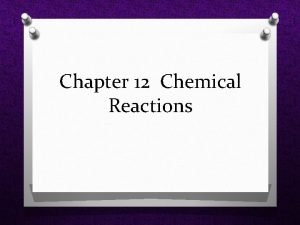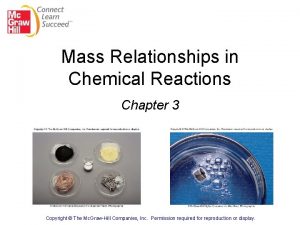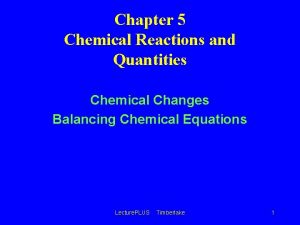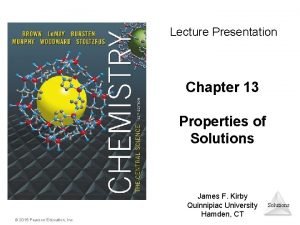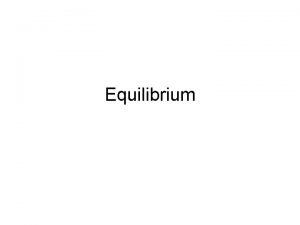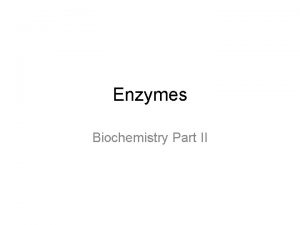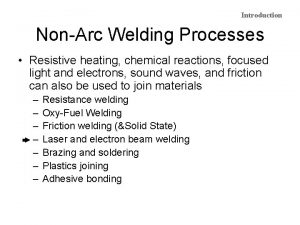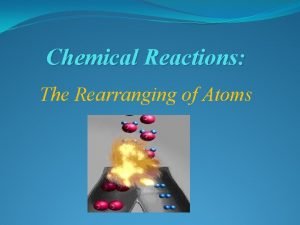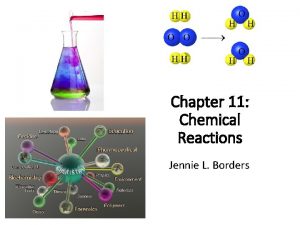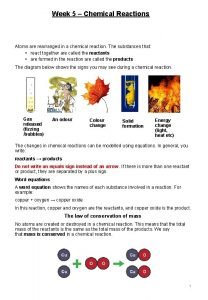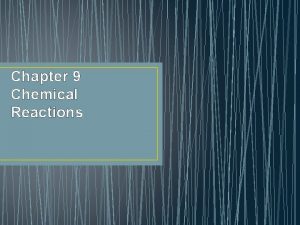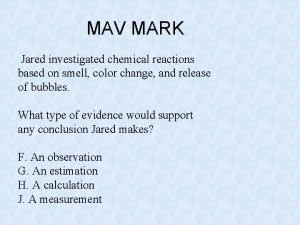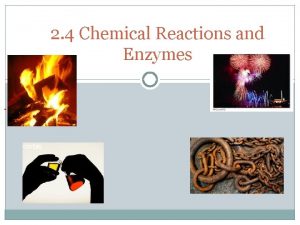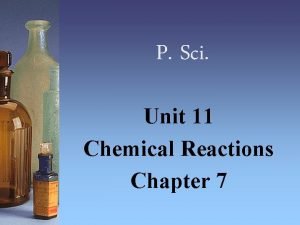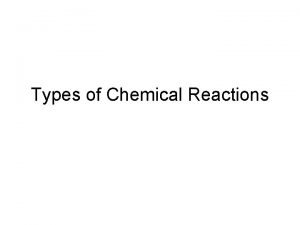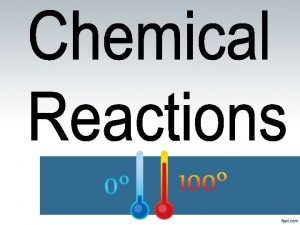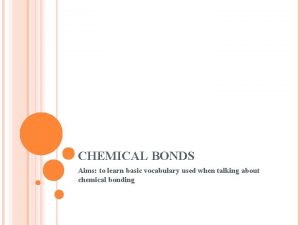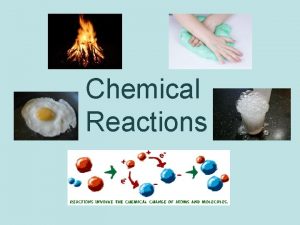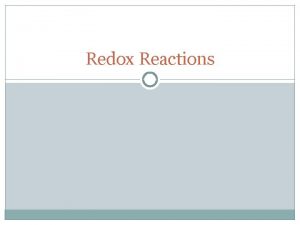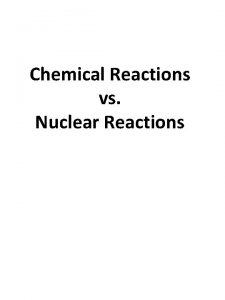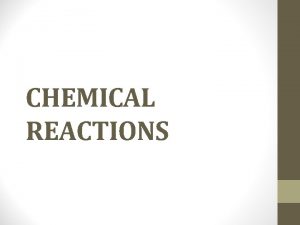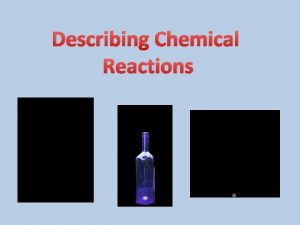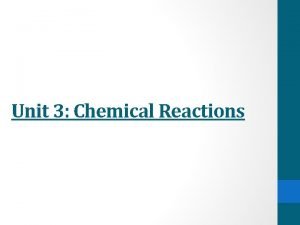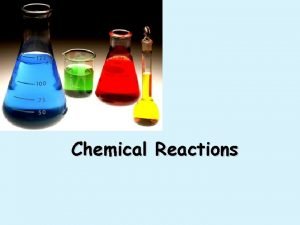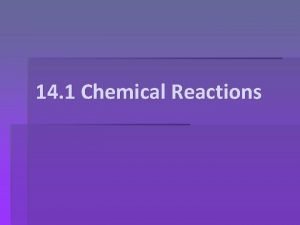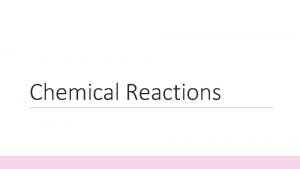Chemical Reactions Understanding Chemical Reactions What are some










































- Slides: 42

Chemical Reactions

Understanding Chemical Reactions • What are some signs that a chemical reaction might have occurred? • What happens to atoms during a chemical reaction? • What happens to the total mass in a chemical reaction?

Changes in Matter • A physical change does not produce new substances. • For example, water molecules are always made up of two hydrogen atoms bonded to one oxygen atom regardless of whether they are solid, liquid, or gas.

Changes in Matter (cont. ) • During a chemical change, one or more substances change into new substances. • A chemical reaction is a process in which atoms of one or more substances rearrange to form one or more new substances.

Signs of a Chemical Reaction • Chemical reactions will always result in a new substance being formed. • Changes in the physical properties of color and odor are all signs that a chemical reaction might have occurred. • If substances get warmer or cooler or if they give off light or sound, it is likely that a chemical reaction has occurred.

Signs of a Chemical Reaction (cont. ) The only way to know if a chemical reaction has occurred is to study the chemical properties of the substances before and after the change. What are some signs that a chemical reaction might have occurred?

What happens in a chemical reaction? • In a chemical reaction, atoms of elements or compounds rearrange and form different elements or compounds. • Atoms rearrange when chemical bonds between atoms break.

Notice that no new atoms are created in a chemical reaction. The existing atoms rearrange and form new substances.

What happens in a chemical reaction? (cont. ) What happens to atoms during a chemical reaction?

Chemical Equations • A chemical equation is a description of a reaction using element symbols and chemical formulas. • In chemical equations, element symbols represent elements and chemical formulas represent compounds.

Chemical Equations (cont. ) • A subscript describes the number of atoms of an element in a compound. • If an element’s symbol does not have a subscript, the compound contains only one atom of that element.


Chemical Equations (cont. ) • A chemical equation includes both the substances that react and the substances that are formed in a chemical reaction. • The starting substances in a chemical reaction are reactants. • The substances produced by the chemical reaction are products.

Chemical Equations (cont. ) product from Latin producere, means “bring forth”

Chemical Equations (cont. ) • The reactants are written to the left of the arrow. • The products are written to the right of the arrow. • The general structure for a chemical equation is: reactant + reactant product + product

An equation is read much like a sentence. This equation is read as “carbon plus oxygen produces carbon dioxide. ”

Photosynthesis & Cellular Respiration • Equations for Photosynthesis & Cellular Respiration are Cyclic • This can be seen in the reactants and products.

Conservation of Mass • The law of conservation of mass states that the total mass of the reactants before a chemical reaction is the same as the total mass of the products after the chemical reaction. • Mass is conserved in a reaction because atoms are conserved. • All atoms at the start of a chemical reaction are present at the end of the reaction.

Hutchings Photography/Digital Light Source Mass is conserved in the reaction between baking soda and vinegar.

Conservation of Mass (cont. ) What happens to the total mass of the reactants in a chemical reaction?

Conservation of Mass (cont. ) A chemical equation is written so that the number of atoms of each element is the same, or balanced, on each side of the arrow.

Conservation of Mass (cont. ) A balanced equation often does not happen automatically when the formulas for reactants and products are written.

Conservation of Mass (cont. ) A balanced equation shows that all atoms at the start of a chemical reaction are present at the end of the chemical reaction

Conservation of Mass (cont. ) • A coefficient is a number placed in front of an element symbol or chemical formula in an equation. • Only coefficients can be changed when balancing an equation.

Conservation of Mass (cont. ) • Changing subscripts changes the identities of the substances that are in the reaction. • When no coefficient is present, only one unit of the substance takes part in the reaction.



Energy Changes and Chemical Reactions • Why do chemical reactions always involve a change in energy? • What is the difference between an endothermic reaction and an exothermic reaction? • What factors can affect the rate of a chemical reaction?

Energy Changes • Chemical bonds contain a form of energy called chemical energy. • Breaking a bond absorbs energy from the surroundings. • The formation of a chemical bond releases energy to the surroundings.

Energy Changes (cont. ) • Some chemical reactions release more energy than they absorb. • Some chemical reactions absorb more energy than they release. • Energy is conserved in all chemical reactions.

Energy Changes (cont. ) Why do chemical reactions involve a change in energy?

Photosynthesis & Cellular Respiration • Photosynthesis is an endothermic reaction • Photosynthesis occurs in the chloroplast of the plant cell • Energy is being absorbed, going in (endo-)

• Chemical reactions that absorb thermal energy are endothermic reactions. • In an endothermic reaction, more energy is required to break the bonds of the reactants than is released when the products form.

Photosynthesis & Cellular Respiration • Cellular Respiration is an exothermic reaction • Cellular respiration occurs in the mitochondria of both plant and animal cells • Energy is being released, going out (exo-)

• An exothermic reaction is a chemical reaction that releases thermal energy. • In an exothermic reaction, more energy is released when the products form than is required to break the bonds in the reactants.

Energy Changes (cont. ) What is the difference between an endothermic reaction and an exothermic reaction?

Activation energy is the minimum amount of energy needed to start a chemical reaction. All reactions need energy to get started

Reaction Rates • The rate of a reaction is the speed at which it occurs. • Chemical reactions occur faster if particles collide more often or move faster when they collide.

Reaction Rates (cont. ) • Increased surface area increases reaction rate because more particles on the surface of a solid come into contact with the particles of another substance. • At higher temperatures, the average speed of particles is greater, particles collide more often, and collisions with more energy are more likely to break chemical bonds.

Reaction Rates (cont. ) • Increasing the concentration of one or more reactants increases collisions between particles, resulting in a fast reaction rate. • In gases, an increase in pressure pushes gas particles closer together, resulting in more collisions.

• A catalyst is a substance that increases reaction rate by lowering the activation energy of a reaction. • An enzyme is a catalyst that speeds up chemical reactions in living cells.

Reaction Rates (cont. ) An inhibitor is a substance that slows, or even stops, a chemical reaction. What factors can affect the rate of a chemical reaction?
 Insidan region jh
Insidan region jh Section 2 classifying chemical reactions
Section 2 classifying chemical reactions Section 2 classifying chemical reactions
Section 2 classifying chemical reactions Understanding chemical reactions worksheet answer key
Understanding chemical reactions worksheet answer key Chemical reactions section 3 reactions in aqueous solutions
Chemical reactions section 3 reactions in aqueous solutions Chemical reactions section 1 chemical changes
Chemical reactions section 1 chemical changes Chapter 18 chemical reactions balancing chemical equations
Chapter 18 chemical reactions balancing chemical equations Example of redox reaction
Example of redox reaction Unit 5 chemical reactions answers
Unit 5 chemical reactions answers Contact forces
Contact forces Sometimes you win some
Sometimes you win some Fire and ice diamante poem
Fire and ice diamante poem Sometimes you win some sometimes you lose some
Sometimes you win some sometimes you lose some Some may trust in horses
Some may trust in horses Some say the world will end in fire some say in ice
Some say the world will end in fire some say in ice Ice cream countable or uncountable noun
Ice cream countable or uncountable noun Mass relationships in chemical reactions
Mass relationships in chemical reactions Indications of chemical reactions
Indications of chemical reactions 5 chemical reactions
5 chemical reactions Solubility rules
Solubility rules Solvent in chemical reactions
Solvent in chemical reactions Equilibrium
Equilibrium Www.biology-roots.com
Www.biology-roots.com Laser beam welding (lbw)
Laser beam welding (lbw) Non examples of chemical reactions
Non examples of chemical reactions Section 1 atoms elements and compounds
Section 1 atoms elements and compounds Chemical reactions rearranging atoms worksheet answers
Chemical reactions rearranging atoms worksheet answers Hcl and sodium hydrogen carbonate
Hcl and sodium hydrogen carbonate Chapter 11 chemical reactions practice problems
Chapter 11 chemical reactions practice problems In chemical reactions atoms are rearranged
In chemical reactions atoms are rearranged Chemical reactions chapter 9 study guide
Chemical reactions chapter 9 study guide 5 general types of chemical reactions
5 general types of chemical reactions Jared investigated chemical reactions
Jared investigated chemical reactions Solvent in chemical reactions
Solvent in chemical reactions Section 2-4 chemical reactions and enzymes
Section 2-4 chemical reactions and enzymes Unit 11 chemical reactions
Unit 11 chemical reactions Predicting products of chemical reactions
Predicting products of chemical reactions Types of chemical reactions and solution stoichiometry
Types of chemical reactions and solution stoichiometry What are the five general types of chemical reactions
What are the five general types of chemical reactions Reaction type
Reaction type Section 2-4 chemical reactions and enzymes
Section 2-4 chemical reactions and enzymes Indications of a chemical reaction
Indications of a chemical reaction Building vocabulary: chemical bonds and reactions
Building vocabulary: chemical bonds and reactions



